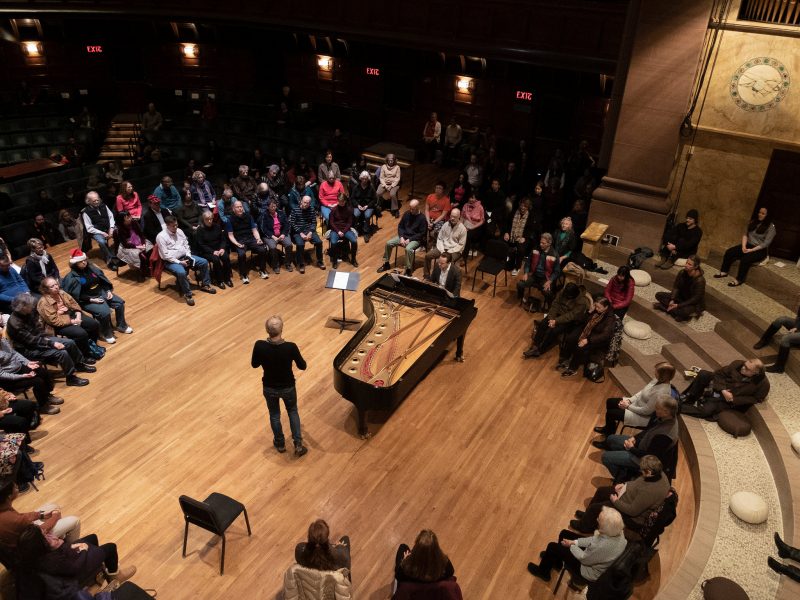Out of Silence, the Music of Meditation
By Corinna da Fonseca-Wollheim
PRINCETON, N.J. — For as long as I can remember, I have loved the silences of the concert hall almost as much as the sounds. The expectant hush that falls on an auditorium when the oboe’s A pierces through the hum of voices and the lights dim. The way a spellbound audience can wrap a protective silence around a pianissimo ending.
But on a recent afternoon in Richardson Auditorium at Princeton University here, silence became an equal partner to the music. I was in the hall for a series called Live Music Meditation. (The next event, on March 28, features the violinist Patricia Kopatchinskaja.) For the first 20 minutes, while listeners quietly filed in, I sat motionless with my eyes closed, noting the sounds of footsteps and the rustle of coats.
Gradually, the calm deepened, broken now and then by a male voice inviting us to focus on our breath, relax our shoulders, and clear our minds. From inside this stillness, the sound of a gong rang out like a bright explosion, followed by waves of amber overtones that seemed to dance with each other in space. Then more silence, long minutes of nothing to hear but the breathing of strangers. When the first notes of a clarinet threaded their way into my consciousness, they seemed to come from inside me.
For the next half-hour, as a piano joined the clarinet, music wound its way through me as sound turned pure sensation. Eventually the last note settled back into silence. Then one more time the gong, followed by that male voice, sounding a little sheepish: “Some people would find it appropriate to clap now.”

The applause, when it came, did seem out of place. And the performers, the clarinetist Martin Frost and the pianist Henrik Mawe, didn’t bow. In an onstage discussion after the unusual concert, they professed to being somewhat overwhelmed.
“We were so aware of you listening to us so intensely that we started to listen to ourselves even more intensely, too,” Mr. Mawe said.
An audience member told the musicians that, for him, “the most special thing was the silence before and after you played. There was anticipation without expectation.”
The series, which is free to the public, was conceived by Dasha Koltunyuk, a pianist and a longtime member of a meditation group led by Matthew Weiner, a dean in the office of religious life at the university. By combining guided meditation with live music, she hoped to create a space in which, she said in a statement, “our tendency toward passivity or judgment while hearing music disperses into a pure, perceptive and receptive state of intense, present listening.”
Composers have long played with silence. In the 20th century, they began to dissolve the border between scripted silence inside the music — the rests — and the ambient silence of a given acoustic space. Ligeti’s “Lux Aeterna” fades into seven bars of rest at the end. John Cage’s “4’33”” consists entirely of notated silence.
These days, more presenters are experimenting with ways to make the audience aware of its role in creating the silence out of which music grows. When the artist Marina Abramovic presented the pianist Igor Levit in Bach’s “Goldberg” Variations at the Park Avenue Armory in 2015, listeners were relieved of their cellphones and outfitted with noise-dampening headphones that helped them sink into deep quiet for 30 minutes before the first notes of Bach.
Concerts inside the Moab Music Festival’s red rock grotto in Utah begin with an invitation to take in the stillness of the natural setting. A two-minute “celebration of silence” is at the center of Chatter in Albuquerque, N.M., and Gather NYC at SubCulture in Manhattan, both Sunday morning series combining classical music and storytelling. In a telephone interview, the violinist and conductor David Felberg, who runs Chatter, said that most audience members close their eyes for that period.
“They’re either meditating or trying to listen to the sounds that exist naturally around them,” he said. “For us, it’s a bit of a palate-cleanser. It’s almost like you’re fresh and ready to listen to the music.”
Mr. Weiner, the Princeton dean, who led the guided meditation, said in an interview that he thinks of the quality created in the room not so much as silence but as sensitivity. In Buddhism, he said, that “doesn’t just mean verbal silence with your tongue. It means softening the constructions in your mind that get in the way of experiencing what’s in front of you.”
As a critic normally tasked with shaping those constructions into written words, I was keenly aware of that softening. And as a diligent but novice meditator, I caught a glimpse, through the music, of what it means to let thoughts bubble up without engaging with them — through applause or judgment.
Here was music not as a text to be read nor a recreational drug to be consumed for mood management, but as an audible process of coming-into-being and fading-away. And, for a short while, listening turned into a state of pure receptivity: beginner’s ear.
